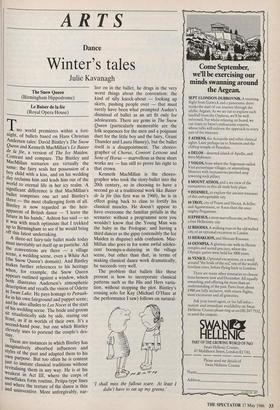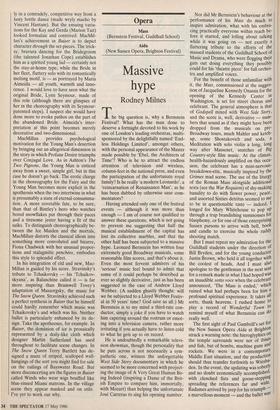ARTS
Winter's tales
Dance Julie Kavanagh
The Snow Queen (Birmingham Hippodrome) Le Baiser de la fee (Royal Opera House) Two world premieres within a fort- night, of ballets based on Hans Christian Andersen tales: David Bintley's The Snow Queen and Kenneth MacMillan's Le Baiser de la fee, a version of The Ice Maiden. Contrast and compare. The Bintley and MacMillan scenarios are virtually the same: the fairy seals her possession of a boy child with a kiss, and on his wedding day reclaims him and leads him out of the world to eternal life in her icy realm. A significant difference is that MacMillan's ballet comprises one act and Bintley's three — the most challenging form of all. Bintley is now regarded as the heir- apparent of British dance — 'I leave the future in his hands,' Ashton has said — so it was with much optimism that I trekked up to Birmingham to see if he would bring off this latest undertaking. A three-act fairy-tale ballet made today must inevitably set itself up as pastiche. All the conventions are there — a village scene, a wedding scene, even a White Act (the Snow Queen's domain). And Bintley makes further references to his heritage when, for example, the Snow Queen appears outlined against a window, which both illustrates Andersen's atmospheric d. escription and recalls the vision of Odette in Swan Lake. He pays homage to Petrush- ka in his own fairground and puppet scene; and he also alludes to Les Noces at the start of his wedding scene. The bride and groom sit ritualistically side by side, staring out front, as if in worlds of their own. It's a second-hand pose, but one which Bintley cleverly uses to portend the couple's des- tiny.
These are instances in which Bintley has imaginatively absorbed influences and styles of the past and adapted them to his o wn purpose. But too often he is content just to imitate classical traditions without revitalising them in any way. He is at his weakest in Act III, where the corps of snowflakes form routine, Petipa-type lines and where the texture of the dance is thin and uninventive. More unforgivably, ear- her on in the ballet, he drags in the very worst things about the convention: the kind of silly knock-about — looking up skirts, pushing people over — that must surely have been what prompted Auden's dismissal of ballet as an art fit only for adolescents. There are gems in The Snow Queen (particularly memorable are the folk sequences for the men and a poignant duet for the little boy and the fairy, Grant Thunder and Laura Hussey), but the ballet itself is a disappointment. The choreo- grapher of Chorus, Consort Lessons and Sons of Horus — marvellous as these short works are — has still to prove his right to that crown.
Kenneth MacMillan is the choreo- grapher who took the story-ballet into the 20th century, so in choosing to have a second go at a traditional work like Baiser de la fee (his first was in 1960), he is in effect going back to class to fortify his classical muscles. He doesn't appear to have overcome the familiar pitfalls in the scenario: without a programme note you wouldn't know that the Young Man was the baby in the Prologue; and having a third dancer as the gipsy (ostensibly the Ice Maiden in disguise) adds confusion. Mac- Millan also goes in for some awful adoles- cent boomps-a-daisying in the village scene, but other than that, in terms of making classical dance work dramatically, he succeeds very well.
The problem that ballets like these present is how to incorporate classical patterns such as the His and Hers varia- tion, without stopping the plot. Bintley's rousing solo for Kay (Michael O'Hare at the performance I saw) follows on natural- `I shall miss the fallout scare. At least I didn't have to eat up my greens.' ly in a comradely, competitive way from a lusty bottle dance (made wryly macho by Vincent Hantam). But the ensuing varia- tions for the Kay and Gerda (Marion Tait) looked formulaic and contrived. MacMil- lan's achievement in Baiser is to depict character through the set-pieces. The trick- sy, bravura dancing for the Bridegroom (the talented Jonathan Cope) establishes him as a spirited young lad — certainly not the stay-at-home type; while the Bride in her fleet, fluttery solo with its romantically melting motif, is — as portrayed by Maria Almeida — all youth, warmth and inno- cence. I would love to have seen what the original Bride, Lynn Seymour, made of this role (although there are glimpses of her in the choreography with its Seymour- patented steps). I suspect she would have done more to evoke pathos on the part of the abandoned Bride. Almeida's inter- pretation at this point becomes merely decorative and two-dimensional.
MacMillan provides psychological motivation for the Young Man's desertion by bringing out an allegorical dimension in the story in which Profane Desire triumphs over Conjugal Love. As in Ashton's The Two Pigeons, the Young Man is enticed away from a sweet, simple girl, but in this case he doesn't go back. The erotic charge in the choreography for the Fairy and the Young Man becomes more explicit in the apotheosis when the two intertwine in what is presumably a state of eternal consumma- tion. A more covetable fate, to be sure, than that of Bintley's hero who watches bored snowflakes put through their paces and a tiresome jester having a fit of the sulks. To distinguish choreographically be- tween the Ice Maiden and the mortals, MacMillan distorts the classical idiom into something more convoluted and bizarre, Fiona Chadwick with her unusual propor- tions and stalagmitic penchees, embodies this style to splendid effect.
In his integration of old and new, Mac- Millan is guided by his score. Stravinsky's tribute to Tchaikovsky — his `Tchaikov- skyana', as Balanchine called it — is far more inspiring than Bramwell Tovey's adaptation of Mussorgsky, the music for The Snow Queen. Stravinsky achieved such a perfect synthesis in Baiser that he himself could hardly remember which music was Tchaikovsky's and which was his. Neither ballet is particularly enhanced by its de- sign. Take the apotheoses, for example. In Bather, the dominion of ice is prosaically represented by a doily-like cloth which designer Martin Sutherland has used throughout to facilitate scene changes. In The Snow Queen Terry Bartlett has de- signed a maze of striped, scalloped wall- hangings of the sort you might find for sale on the railings of Bayswater Road. But more disconcerting are the figures in Barer called Winds who wear wigs bouffed like blue-rinsed Miami matrons. In the village scene they appear masked and on stilts. I've yet to work out why.



















































 Previous page
Previous page